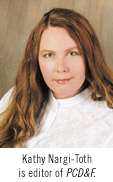
We see, in the pursuit of performance, greater use of advanced RF,
mixed digital and analog signals, and ultra high-speed circuitry that,
when designed in tandem, can effectively deliver seamless connectivity
across all our coveted consumer electronics.
Indeed, the complexity of these devices increases exponentially to the
number of features we desire and space reductions we crave
(let’s call this Kathy’s First Postulate). Product
differentiation has become the critical component of the design, often
trumping function. It adds another layer of constraint: the form factor
equation. And then there’s getting to market faster, the key
driver on the product development express, imposing its own relentless
pressures throughout the entire supply chain which just so happens to
also demand improved productivity, better quality, lower cost and
reduced risk.
That’s not all. The world is becoming environmentally fussy,
and while all the do-goodedness doesn’t always add up to a
cleaner and safer world, it does pile on a set of
“green” constraints. The latest considerations to
address the Energy Using Products Directive (EuP) objectives for
reducing power consumption call for the elimination of standby power
options in all consumer electronics. Finding ways to “cut the
power” would then become an immediate goal across the whole
of the electronics design supply chain in the coming year.
It seems at times, designing a PCB is mission impossible.
A few weeks ago at
PCB East, key design tool vendors joined to talk to
designers about the current challenges and programs underway for
next-generation design tools. They also explained emerging technologies
that might be forthcoming and how we might as an industry integrate
these opportunities into the electronics supply chain with minimal
disruption. Representatives from Agilent EEsof EDA, Cadence, Mentor
Graphics and Zuken participated.
Unlike on the fab side, this type of dialog has been missing for some
time in design circles. It has been years since the major EDA tools
vendors and their customers – aka the designers –
have had access to a cross-platform, interactive forum at a PCB focused
function. Certainly there are valuable conversations between design
tool users and their vendors in user group forums, but this is not the
same as the type of dialog that cuts across tools vendors into the
realm of true supply-chain communication.
Integration and product complexity, not to mention business drivers,
are pushing rapid evolution on the design process. Co-design of the
electronic platform, from IC-to-package-to-PCB, is beginning to appear
in high-end applications. Tools are advancing to facilitate these
co-design scenarios. In the near future, product differentiation will
be determined by system innovation and company-specific customization
involving the entire interconnection platform, not just in the PCB. It
is a critical time for designers to talk to each other and keep current
in all the technology disciplines.
Recently, we’ve seen a number of enabling technologies
brought to market through the collaboration of companies –
some even competitors – to the benefit of the industry.
It’s a paradox: differentiation through partnerships. Yet
this business model is becoming increasingly popular in light of the
tremendous challenges and expense companies face bringing a product to
market.
Moving forward, a critical aspect of design will be verification and
simulation. A recent collaboration between Cadence and Mentor in the IC
design space created an open-source verification methodology. Similar
bridges are being laid between the design spheres, through co-design
tools, and to address conflicts found in mixed technology designs that
contain RF and high-speed analog/digital signals.
The faster things move, the more important it is to keep open the lines
of communication. Communication makes or breaks any partnership. Based
on the success of the designer/tool vendor forum at
PCB East, we will
offer a number of dialog-provoking opportunities at
PCB West in
September (more on that next month). In the meantime, if
you’ve identified a weak link in the chain that needs
attention, let us know. We are here to facilitate the discussion.
This month marks the debut of Final Finish Forum, a column featuring
experts in the area of final finishes. This topic forms a natural
bridge from PCB fab to assembly and involves the designer because the
OEM or ODM often choose the finish. Look for more new and familiar
faces as we expand our list of regular columnists and contributing
authors over the coming months.








 We see, in the pursuit of performance, greater use of advanced RF,
mixed digital and analog signals, and ultra high-speed circuitry that,
when designed in tandem, can effectively deliver seamless connectivity
across all our coveted consumer electronics.
We see, in the pursuit of performance, greater use of advanced RF,
mixed digital and analog signals, and ultra high-speed circuitry that,
when designed in tandem, can effectively deliver seamless connectivity
across all our coveted consumer electronics. 




